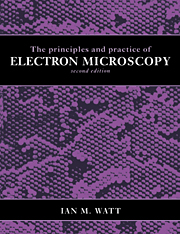Book contents
- Frontmatter
- Contents
- Preface to first edition
- Preface to second edition
- 1 Microscopy with light and electrons
- 2 Electron–specimen interactions: processes and detectors
- 3 The electron microscope family
- 4 Specimen preparation for electron microscopy
- 5 The interpretation and analysis of micrographs, pages 189 to 223
- The interpretation and analysis of micrographs, pages 224 to 262
- 6 Analysis in the electron microscope
- 7 Specialised EM- and other microscopical and analytical techniques
- 8 Examples of the use of electron microscopy
- Appendixes
- Bibliography
- Name index
- Subject index
2 - Electron–specimen interactions: processes and detectors
Published online by Cambridge University Press: 05 June 2012
- Frontmatter
- Contents
- Preface to first edition
- Preface to second edition
- 1 Microscopy with light and electrons
- 2 Electron–specimen interactions: processes and detectors
- 3 The electron microscope family
- 4 Specimen preparation for electron microscopy
- 5 The interpretation and analysis of micrographs, pages 189 to 223
- The interpretation and analysis of micrographs, pages 224 to 262
- 6 Analysis in the electron microscope
- 7 Specialised EM- and other microscopical and analytical techniques
- 8 Examples of the use of electron microscopy
- Appendixes
- Bibliography
- Name index
- Subject index
Summary
In light microscopy the light falling on an object is reflected, transmitted, scattered, absorbed, or re-emitted at another wavelength. The main modes of light microscopy (reflected, transmitted bright-field and dark-field, fluorescence) result from these effects.
In electron microscopy the possibilities are much wider, because the greater amount of energy carried by the illumination can cause a number of different effects to occur in the specimen. A range of microscopical and analytical modes is possible, which makes the electron microscope the basis of a very powerful analytical sytem. Before going on to deal with the microscopes themselves it is useful to consider the range of possible electron–specimen interactions, which need to be taken into account when trying to interpret the images and analyses from electron microscopes.
Beam–specimen interactions
Figure 2.1 shows schematically and very approximately the paths taken by a small number of high-energy electrons when they impinge on a specimen in an electron microscope. Two thicknesses of specimen are considered – corresponding to a thin sample for the TEM and a bulk sample for the SEM.
Electron trajectories are deflected by collisions with specimen atoms. These may be either elastic, when the electron is deflected (even up to 180°) but no energy interchange occurs, or inelastic, when the electron interacts with the atom and supplies energy for a further process to occur, resulting in emission of an electron and/or electromagnetic radiation, but with very small deviation of track.
- Type
- Chapter
- Information
- The Principles and Practice of Electron Microscopy , pp. 30 - 58Publisher: Cambridge University PressPrint publication year: 1997

